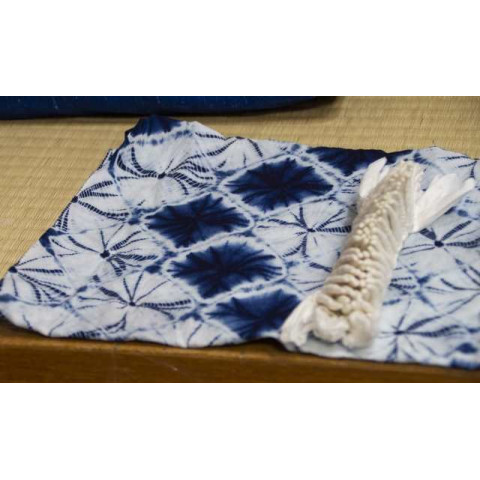
Arimatsu Shibori is a traditional Japanese tie-dyeing technique that originated in the Arimatsu region of Nagoya, Japan. Shibori is a method of resist dyeing, where fabric is folded, tied, stitched, or clamped before dyeing, creating intricate patterns and designs. Arimatsu Shibori has a long history and is known for its specific techniques and patterns.
In Arimatsu Shibori, the fabric is typically folded and secured with thread before dyeing. The tied areas resist the dye, creating patterns when the fabric is unfolded. The patterns can range from simple geometric shapes to more intricate and complex designs. Common motifs include circles, squares, and lines.
One of the unique aspects of Arimatsu Shibori is its association with the Arimatsu-Narumi region, which has been a centre for Shibori production for centuries. The craft has been passed down through generations, and there are artisans in the region who continue to practice and preserve these traditional techniques.
Traditionally, natural dyes were commonly used in Arimatsu Shibori. These natural dyes were derived from plant sources, such as indigo plants, and sometimes even insect sources, like cochineal insects. The most iconic and widely associated colour with Shibori, including Arimatsu Shibori, is indigo blue. Indigo dye has been a significant part of Japanese textile traditions, and it is known for its deep, rich blue colour. The process of using indigo dye in Shibori involves dipping the fabric into a vat of indigo dye multiple times, allowing it to oxidize and develop its characteristic blue hue. The resist techniques applied in Shibori create beautiful patterns as the dye penetrates the fabric selectively, depending on where it's resisted or blocked. Arimatsu Shibori often involves the use of Aizome, which refers to the traditional Japanese indigo dyeing technique. Aizome uses natural indigo dye derived from the leaves of the indigo plant. This dye has been used in Japan for centuries and is known for its deep and distinctive blue colour.
The use of Aizome indigo dye not only imparts a beautiful blue colour to the textiles but also reflects the historical and cultural significance of indigo dyeing in Japan. While synthetic dyes are also used in contemporary Shibori practices, traditional artisans often value the authenticity and connection to the heritage that comes with using natural Aizome indigo dye.
Arimatsu Shibori is often used to create textiles for kimonos and other traditional Japanese garments. Today, it is also employed in contemporary fashion and art, where artists and designers incorporate Shibori techniques into various textile products. Arimatsu Shibori represents a rich cultural tradition in Japan, showcasing the skill and artistry of Japanese craftsmen in the realm of textile design and dyeing.
